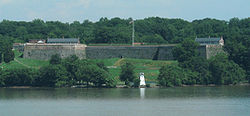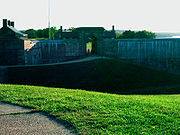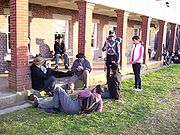
Fort Washington Park
Encyclopedia
Fort Washington, located near the community of Fort Washington, Maryland
, USA, was for many decades the only defensive fort protecting Washington D.C. The original fort, overlooking the Potomac River
, was completed in 1809, and was named Fort Warburton. During the War of 1812
, the fort was destroyed by its own garrison during a British advance.
The current historic fort — maintained by the National Park Service
— was initially constructed in 1824. It is a stone structure with a good cannon shot down the Potomac River
. The fort was extensively remodeled in the 1840s and 1890s. The Fort was turned over to the U.S. Department of the Interior in 1946 after its last military personnel departed.
The expansive grounds of the present Fort Washington Park, with its extensive hiking/bicycle paths and river view, are a scenic venue for picnicking, fishing, and outdoor recreation. Historical re-enactments are held periodically at the Fort, and there is a small museum. In 2006, repairs were done to shore up the crumbling outer wall, in preparation for the 200th anniversary.
The Fort Washington Light
, located below the fort, was established in 1857. The current tower, standing 28 feet tall, was constructed in 1882.



Twelve days after the destruction of the fort, James Monroe
, the acting Secretary of War, hired Major Pierre L’Enfant to construct new defenses. In November 1814, Monroe questioned L'Enfant actions, asking for less spending. On July 14, 1815, work was halted. Two months later, L'Enfant was replaced by Lieutenant Colonel Walker K. Armistead of the U.S. Army Corps of Engineers. The fort was completed on October 2, 1824, at a total cost of $426,000, excluding armament, which had not yet been installed.
Extensive remodeling was performed in the 1840s and the first guns were mounted in 1846. The masonry fort was occupied by soldiers from the First, Third and Fourth U.S. Artillery during its early history. Except for a few guns at the Washington Arsenal, Fort Washington was the only defense for the nation’s capital until the Civil War when a circle of temporary forts was built around the city. Battery Rogers and Fort Foote were the only seacoast forts in the system and armed with large Rodman and Parrott cannons. Fort Washington was garrisoned as the outer defense for the city. Companies of the First and Fourth Artillery as well as numerous state artillery units passed through the post during the war.
s and a magazine were partially constructed. In 1875, funds for the project was withdrawn and the post was abandoned until 1891.
In 1886, a new defense system, consisting of rifled steel guns in concrete emplacements was authorized, and work began at Fort Washington in 1891. The next year ground was broken for Battery B, later named Battery Decatur, and the guns were mounted in 1896. Eventually eight concrete batteries at Fort Washington and four at Fort Hunt made up the Potomac Defense Command. In the years prior to World War I
, Fort Washington was downgraded to harbor defense and the large guns removed.
.
In 1939 the post was abandoned and turned over to the U.S. Department of the Interior; the plan was use it as a terminal point for a bridge across the Potomac River and a parkway
to be built along the shore. A barracks for the Civilian Conservation Corps
was built that year on the post.
in late 1941, Fort Washington was returned to the army and became the home of the U.S. Army Adjutant General’s School. After the war ended, in 1945, the Veterans Administration
managed the post hospital and other government agencies occupied some of the buildings. In 1946 the fort was returned to the Department of the Interior. Many of the buildings built between the two world wars were removed. Since 1946, the post has been a park, now run by the National Park Service
.
Fort Washington, Maryland
Fort Washington, Maryland is an unincorporated area and census-designated place in Prince George's County, Maryland in the suburbs of the capital city of the United States of America, Washington, D.C., south of the downtown district. It is a prosperous community with an African American majority...
, USA, was for many decades the only defensive fort protecting Washington D.C. The original fort, overlooking the Potomac River
Potomac River
The Potomac River flows into the Chesapeake Bay, located along the mid-Atlantic coast of the United States. The river is approximately long, with a drainage area of about 14,700 square miles...
, was completed in 1809, and was named Fort Warburton. During the War of 1812
War of 1812
The War of 1812 was a military conflict fought between the forces of the United States of America and those of the British Empire. The Americans declared war in 1812 for several reasons, including trade restrictions because of Britain's ongoing war with France, impressment of American merchant...
, the fort was destroyed by its own garrison during a British advance.
The current historic fort — maintained by the National Park Service
National Park Service
The National Park Service is the U.S. federal agency that manages all national parks, many national monuments, and other conservation and historical properties with various title designations...
— was initially constructed in 1824. It is a stone structure with a good cannon shot down the Potomac River
Potomac River
The Potomac River flows into the Chesapeake Bay, located along the mid-Atlantic coast of the United States. The river is approximately long, with a drainage area of about 14,700 square miles...
. The fort was extensively remodeled in the 1840s and 1890s. The Fort was turned over to the U.S. Department of the Interior in 1946 after its last military personnel departed.
The expansive grounds of the present Fort Washington Park, with its extensive hiking/bicycle paths and river view, are a scenic venue for picnicking, fishing, and outdoor recreation. Historical re-enactments are held periodically at the Fort, and there is a small museum. In 2006, repairs were done to shore up the crumbling outer wall, in preparation for the 200th anniversary.
The Fort Washington Light
Fort Washington Light
Fort Washington Light is an unusual lighthouse located on the banks of the Potomac River on the grounds of its namesake fort. Although there has been a lighthouse on this location since 1857, the current light was converted from a fog bell tower in 1901....
, located below the fort, was established in 1857. The current tower, standing 28 feet tall, was constructed in 1882.
History



1808-1871
Construction on first Fort Washington, then called Fort Warburton, was completed on December 1, 1809. In August 1814, with British forces in Washington (having marched overland) and British ships heading up the Potomac, the fort was destroyed by its own garrison to prevent it from being captured and occupied by the British.Twelve days after the destruction of the fort, James Monroe
James Monroe
James Monroe was the fifth President of the United States . Monroe was the last president who was a Founding Father of the United States, and the last president from the Virginia dynasty and the Republican Generation...
, the acting Secretary of War, hired Major Pierre L’Enfant to construct new defenses. In November 1814, Monroe questioned L'Enfant actions, asking for less spending. On July 14, 1815, work was halted. Two months later, L'Enfant was replaced by Lieutenant Colonel Walker K. Armistead of the U.S. Army Corps of Engineers. The fort was completed on October 2, 1824, at a total cost of $426,000, excluding armament, which had not yet been installed.
Extensive remodeling was performed in the 1840s and the first guns were mounted in 1846. The masonry fort was occupied by soldiers from the First, Third and Fourth U.S. Artillery during its early history. Except for a few guns at the Washington Arsenal, Fort Washington was the only defense for the nation’s capital until the Civil War when a circle of temporary forts was built around the city. Battery Rogers and Fort Foote were the only seacoast forts in the system and armed with large Rodman and Parrott cannons. Fort Washington was garrisoned as the outer defense for the city. Companies of the First and Fourth Artillery as well as numerous state artillery units passed through the post during the war.
1872 to 1916
In 1872 the garrison was removed and additional property purchased to construct a new defense system. Between 1873 and 1875, four 15-inch Rodman gunRodman gun
Rodman gun refers to a series of American Civil War-era columbiads designed by Union artilleryman Thomas Jackson Rodman . The guns were designed to fire both shot and shell. These heavy guns were intended to be mounted in seacoast fortifications. They were built in 8-inch, 10-inch, 13-inch,...
s and a magazine were partially constructed. In 1875, funds for the project was withdrawn and the post was abandoned until 1891.
In 1886, a new defense system, consisting of rifled steel guns in concrete emplacements was authorized, and work began at Fort Washington in 1891. The next year ground was broken for Battery B, later named Battery Decatur, and the guns were mounted in 1896. Eventually eight concrete batteries at Fort Washington and four at Fort Hunt made up the Potomac Defense Command. In the years prior to World War I
World War I
World War I , which was predominantly called the World War or the Great War from its occurrence until 1939, and the First World War or World War I thereafter, was a major war centred in Europe that began on 28 July 1914 and lasted until 11 November 1918...
, Fort Washington was downgraded to harbor defense and the large guns removed.
1917 to 1940
During World War I, the post was used as a staging area for troops being sent to France. The 8th Provisional Artillery Battalion was organized at the post and sent to France where they became the 53rd Railroad Artillery Regiment. After the war the 3rd Battalion 12th Infantry moved in and became the ceremonial unit for the Military District of WashingtonMilitary District of Washington
The United States Army Military District of Washington is one of nineteen major commands of the United States Army. Its headquarters are located at Fort Lesley J. McNair in Washington, D.C...
.
In 1939 the post was abandoned and turned over to the U.S. Department of the Interior; the plan was use it as a terminal point for a bridge across the Potomac River and a parkway
Parkway
The term parkway has several distinct principal meanings and numerous synonyms around the world, for either a type of landscaped area or a type of road.Type of landscaped area:...
to be built along the shore. A barracks for the Civilian Conservation Corps
Civilian Conservation Corps
The Civilian Conservation Corps was a public work relief program that operated from 1933 to 1942 in the United States for unemployed, unmarried men from relief families, ages 18–25. A part of the New Deal of President Franklin D...
was built that year on the post.
1941 to present
When the United States entered World War IIWorld War II
World War II, or the Second World War , was a global conflict lasting from 1939 to 1945, involving most of the world's nations—including all of the great powers—eventually forming two opposing military alliances: the Allies and the Axis...
in late 1941, Fort Washington was returned to the army and became the home of the U.S. Army Adjutant General’s School. After the war ended, in 1945, the Veterans Administration
United States Department of Veterans Affairs
The United States Department of Veterans Affairs is a government-run military veteran benefit system with Cabinet-level status. It is the United States government’s second largest department, after the United States Department of Defense...
managed the post hospital and other government agencies occupied some of the buildings. In 1946 the fort was returned to the Department of the Interior. Many of the buildings built between the two world wars were removed. Since 1946, the post has been a park, now run by the National Park Service
National Park Service
The National Park Service is the U.S. federal agency that manages all national parks, many national monuments, and other conservation and historical properties with various title designations...
.

